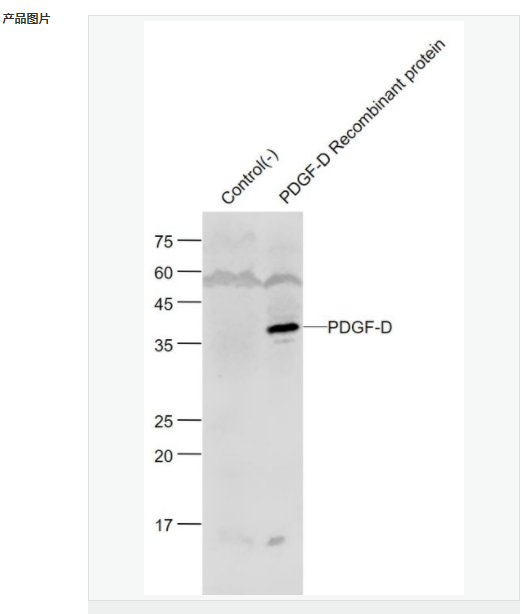

貨號
產(chǎn)品規(guī)格
售價(jià)
備注
BN41168R-100ul
100ul
¥2360.00
交叉反應(yīng):Human(predicted:Mouse,Rat,Dog,Pig,Cow,Rabbit,Sheep) 推薦應(yīng)用:WB,IHC-P,ELISA
BN41168R-200ul
200ul
¥3490.00
交叉反應(yīng):Human(predicted:Mouse,Rat,Dog,Pig,Cow,Rabbit,Sheep) 推薦應(yīng)用:WB,IHC-P,ELISA
產(chǎn)品描述
| 英文名稱 | PDGF-D/SCDGFB |
| 中文名稱 | 血小板源性生長因子D/脊髓源性生長因子B抗體 |
| 別 名 | IEGF; Iris expressed growth factor; Iris-expressed growth factor; MGC26867; MSTP036; PDGF D; PDGF-D; PDGFD; PDGFD latent form; PDGFD receptor-binding form; PDGFD_HUMAN; Platelet derived growth factor D; Platelet-derived growth factor D; receptor-binding form; SCDGF B; SCDGF-B; Spinal cord derived growth factor B; Spinal cord-derived growth factor B. |
| 研究領(lǐng)域 | 腫瘤 心血管 免疫學(xué) 神經(jīng)生物學(xué) 信號轉(zhuǎn)導(dǎo) 生長因子和激素 |
| 抗體來源 | Rabbit |
| 克隆類型 | Polyclonal |
| 交叉反應(yīng) | Human, (predicted: Mouse, Rat, Dog, Pig, Cow, Rabbit, Sheep, ) |
| 產(chǎn)品應(yīng)用 | WB=1:500-2000 ELISA=1:5000-10000 IHC-P=1:100-500 (石蠟切片需做抗原修復(fù)) not yet tested in other applications. optimal dilutions/concentrations should be determined by the end user. |
| 分 子 量 | 14/41kDa |
| 細(xì)胞定位 | 細(xì)胞外基質(zhì) 分泌型蛋白 |
| 性 狀 | Liquid |
| 濃 度 | 1mg/ml |
| 免 疫 原 | KLH conjugated synthetic peptide derived from human SCDGFB:271-370/370 |
| 亞 型 | IgG |
| 純化方法 | affinity purified by Protein A |
| 儲(chǔ) 存 液 | 0.01M TBS(pH7.4) with 1% BSA, 0.03% Proclin300 and 50% Glycerol. |
| 保存條件 | Shipped at 4℃. Store at -20 °C for one year. Avoid repeated freeze/thaw cycles. |
| PubMed | PubMed |
| 產(chǎn)品介紹 | SCDGFB (Spinal cord derived growth factor B) is a member of the platelet derived growth factor family. It only forms homodimers and does not dimerize with the other three family members. It is a potent mitogen for cells of mesenchymal origin. It is activated by proteolytic cleavage and this active form acts as a specific ligand for beta platelet derived growth factor receptor. It is released by platelets upon wounding and plays an important role in stimulating adjacent cells to grow and thereby heals the wound. It induces macrophage recruitment, increased interstitial pressure, and blood vessel maturation during angiogenesis. Function: Growth factor that plays an essential role in the regulation of embryonic development, cell proliferation, cell migration, survival and chemotaxis. Potent mitogen for cells of mesenchymal origin. Plays an important role in wound healing. Induces macrophage recruitment, increased interstitial pressure, and blood vessel maturation during angiogenesis. Can initiate events that lead to a mesangial proliferative glomerulonephritis, including influx of monocytes and macrophages and production of extracellular matrix (By similarity). Subunit: Homodimer; disulfide-linked. Interacts with PDGFRB homodimers, and with heterodimers formed by PDGFRA and PDGFRB. Subcellular Location: Secreted. Note=Released by platelets upon wounding. Tissue Specificity: Expressed at high levels in the heart, pancreas, adrenal gland and ovary and at low levels in placenta, liver, kidney, prostate, testis, small intestine, spleen and colon. In the kidney, expressed by the visceral epithelial cells of the glomeruli. A widespread expression is also seen in the medial smooth muscle cells of arteries and arterioles, as well as in smooth muscle cells of vasa rectae in the medullary area. Expressed in the adventitial connective tissue surrounding the suprarenal artery. In chronic obstructive nephropathy, a persistent expression is seen in glomerular visceral epithelial cells and vascular smooth muscle cells, as well as de novo expression by periglomerular interstitial cells and by some neointimal cells of atherosclerotic vessels. Expression in normal prostate is seen preferentially in the mesenchyme of the gland while expression is increased and more profuse in prostate carcinoma. Expressed in many ovarian, lung, renal and brain cancer-derived cell lines. Post-translational modifications: Activated by proteolytic cleavage. Proteolytic removal of the N-terminal CUB domain releasing the core domain is necessary for unmasking the receptor-binding epitopes of the core domain. Cleavage after Arg-247 or Arg-249 by urokinase plasminogen activator gives rise to the active form. Similarity: Belongs to the PDGF/VEGF growth factor family. Contains 1 CUB domain. SWISS: Q9GZP0 Gene ID: 80310 Database links: Entrez Gene: 80310 Human Entrez Gene: 71785 Mouse Omim: 609673 Human SwissProt: Q9GZP0 Human SwissProt: Q925I7 Mouse Unigene: 352298 Human Unigene: 390122 Mouse Unigene: 64493 Rat Important Note: This product as supplied is intended for research use only, not for use in human, therapeutic or diagnostic applications. |
